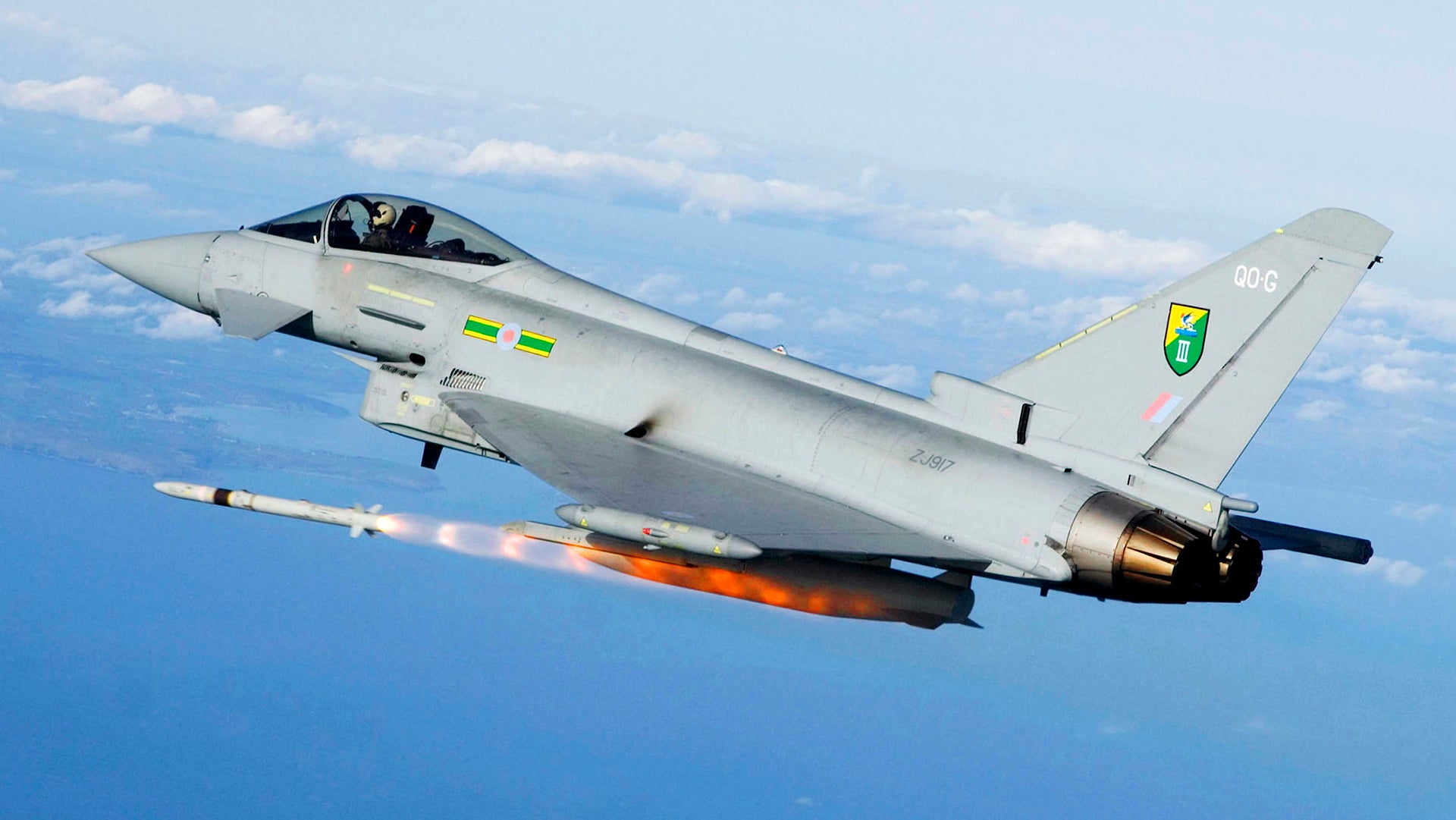The U.K. Ministry of Defense has confirmed that a Royal Air Force (RAF) Typhoon FGR4 fighter jet shot down a hostile drone over Syria earlier this week, in what is the first confirmed air-to-air engagement for this type in British service. The event was also the first time that the RAF has fired an air-to-air missile during Operation Shader, the British contribution to the U.S.-led campaign against ISIS in the Middle East. It is seemingly also the first time since the late 1940s that an RAF pilot, flying an RAF plane, has downed an enemy aircraft of any kind in aerial combat.
While details so far are limited, British authorities have confirmed that the Typhoon downed a “small hostile drone” on December 14 and that this unmanned aerial vehicle was determined to have posed a threat to coalition forces in the area. The drone activity had initially been detected over the coalition base of At Tanf in Syria and RAF Typhoons conducting routine patrols in the area were tasked to investigate. The drone, of a type so far not identified, was engaged once it became clear that it was a threat, although it’s unclear if it was armed.

“This strike is an impressive demonstration of the RAF’s ability to take out hostile targets in the air which pose a threat to our forces,” said the U.K. Defense Secretary Ben Wallace in a statement. “We continue to do everything we can alongside our Coalition partners to stamp out the terrorist threat and protect our personnel and our partners.”
Regardless, this British aerial engagement is significant for a number of firsts. It is especially notable that the drone kill was achieved using an infrared-guided MBDA Advanced Short-Range Air-to-Air Missile, or ASRAAM, which is not known to have been used in combat before now. Outside the RAF, the only other ASRAAM operator is Australia. The ASRAAM will have required an infrared signature to engage the drone, but it’s known for having a longer range than equivalent heat-seeking missiles such as the AIM-9X Sidewinder.
“Despite the small size of the drone making it a very challenging target, it was successfully shot down using an ASRAAM and the threat eliminated,” the defense ministry confirmed.

Also significant is the fact that the incident took place near At Tanf, located near the Iraqi and Jordanian borders, and a key U.S. outpost that has been a previous source of tensions. The same location has come under drone attack before, with a coordinated raid in October blamed on Iran or Iranian-backed militia groups. Prior to that, in June 2017, a U.S. Air Force F-15E Strike Eagle fighter also shot down a drone after it had released an unspecified weapon outside At Tanf.
The Typhoon, or rather the flight of two Typhoons, involved in the latest incident would have been operating from RAF Akrotiri on the island of Cyprus in the eastern Mediterranean.
According to Capt. Bill Urban, the spokesman for U.S. Central Command, there were two drones that entered the airspace around At Tanf. “As one of the [drones] continued its course deeper into the At Tanf Deconfliction Zone, it was assessed as demonstrating hostile intent and was shot down,” he said. Initial reports erroneously suggested a U.S. fighter jet had made the kill. As for the second drone, it turned and left the area.
The Typhoon, for its part, has become the workhorse of the RAF combat fleet over the Middle East, following the withdrawal of the Tornado GR4 strike aircraft. However, it has been used up till now for air-to-ground missions and reconnaissance. Indeed, the Typhoon underwent a program codenamed Centurion to allow it to take on the strike missions previously flown by Tornados, including using the Storm Shadow cruise missile and the Brimstone precision anti-armor missile, as well as the Paveway IV that was already available to the RAF Typhoon.

While the U.K. Ministry of Defense has described the drone-kill incident as “a tribute to the skill and professionalism of Royal Air Force pilots,” it is also very likely of considerable historical significance. While RAF pilots did score some aerial victories flying Royal Navy jets against Argentinian opposition in the Falklands War of 1982, we have to go back as far as 1948, and the Arab-Israeli conflict, to find the last time an RAF pilot, flying an RAF aircraft, was successful in an air-to-air engagement. At that time, the RAF aircraft being flown was a Spitfire — a far cry from the Typhoons being operated over the Middle East today.
This incident isn’t the first time At Tanf has been targeted by drones, and these incursions — including the most recent one in October — have been tied directly or indirectly to Iran. Whatever the origin of the two drones involved in this latest incident, it points again to the growing threat posed by these kinds of small unmanned aerial vehicles, one that the United States, among others, is taking increasingly seriously.
With the drone threat now a fixed part of the dynamic in the Middle East, British, as well as American and other allied jets, will continue to be on call to guard against them.
Contact the author: thomas@thedrive.com
